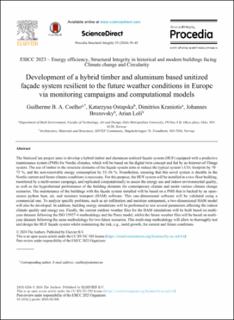| dc.contributor.author | Coelho, Guilherme Barreto Arez | |
| dc.contributor.author | Ostapska, Katarzyna | |
| dc.contributor.author | Kraniotis, Dimitrios | |
| dc.contributor.author | Brozovsky, Johannes Georg | |
| dc.contributor.author | Loli, Arian | |
| dc.date.accessioned | 2024-04-02T07:34:56Z | |
| dc.date.available | 2024-04-02T07:34:56Z | |
| dc.date.created | 2024-04-01T13:18:45Z | |
| dc.date.issued | 2024 | |
| dc.identifier.issn | 2452-3216 | |
| dc.identifier.uri | https://hdl.handle.net/11250/3124379 | |
| dc.description.abstract | The StaticusCare project aims to develop a hybrid timber and aluminum unitized façade system (HUF) equipped with a predictive
maintenance system (PMS) for Nordic climates, which will be based on the digital twin concept and fed by an Internet-of-Things
system. The use of timber in the structure elements of the façade system aims to reduce the typical system’s CO2 footprint by 70–
75 %, and the non-renewable energy consumption by 53–56 %. Nonetheless, ensuring that this novel system is durable in the
Nordic current and future climate conditions is necessary. For this purpose, the HUF system will be installed in a two-floor building,
monitored by a multi-sensor campaign, and replicated computationally to assess the energy use and indoor environmental quality,
as well as the hygrothermal performance of the building elements for contemporary climate and under various climate change
scenarios. The maintenance of the buildings with the façade system installed will be based on a PMS that is backed by an open-
source python heat, air, and moisture transport (HAM) software. This one-dimensional software will be validated using a
commercial one. To analyze specific problems, such as air infiltration and moisture entrapment, a two-dimensional HAM model
will also be developed. In addition, building energy simulations will be performed to test several parameters affecting the indoor
climate quality and energy use. Finally, the current outdoor weather files for the HAM simulations will be built based on multi-
year datasets following the ISO 15927-4 methodology and the Perez model, whilst the future weather files will be based on multi-
year datasets following the same methodology for two future scenarios. This multi-step methodology will allow to thoroughly test
and design the HUF façade system whilst minimizing the risk, e.g., mold growth, for current and future conditions. | en_US |
| dc.language.iso | eng | en_US |
| dc.rights | Attribution-NonCommercial-NoDerivatives 4.0 Internasjonal | * |
| dc.rights.uri | http://creativecommons.org/licenses/by-nc-nd/4.0/deed.no | * |
| dc.title | Development of a hybrid timber and aluminum based unitized façade system resilient to the future weather conditions in Europe via monitoring campaigns and computational models | en_US |
| dc.type | Peer reviewed | en_US |
| dc.type | Journal article | en_US |
| dc.description.version | publishedVersion | en_US |
| cristin.ispublished | true | |
| cristin.fulltext | original | |
| cristin.qualitycode | 1 | |
| dc.identifier.doi | 10.1016/j.prostr.2024.02.006 | |
| dc.identifier.cristin | 2257767 | |
| dc.source.journal | Procedia Structural Integrity | en_US |

